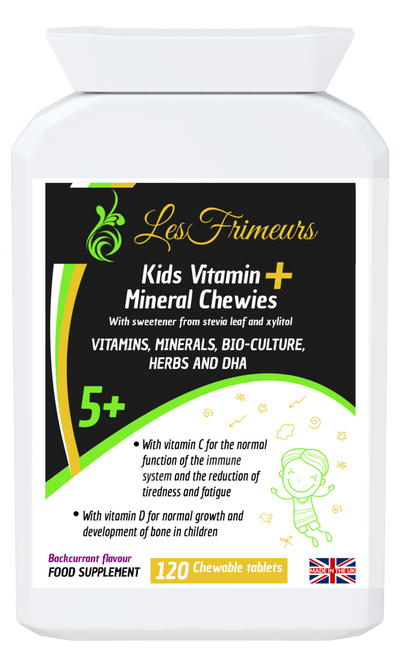Multi-Mushroom Organic Complex
Product summary:
90 capsules
Multi-Mushroom Organic Complex with Immunity Support is an organic mushroom immunity blend with Maitake, Reishi, Shiitake, Lion's Mane, Chaga PLUS Astragalus root, Acerola fruit and black pepper - all in one convenient capsule, providing important nutrients (such as vitamin C and vegan vitamin D).
Organic mushrooms blend with organic Vitamin C to support a strong and healthy immune system. Keep strong and healthy.
As well as its primary immunity properties (backed by science - see below), this special complex supports everything from energy levels, to protection of cells from oxidative stress.
The ingredients used in this food supplement have been certified organic by the Soil Association, meaning no toxic pesticides or fertilisers have been used resulting in a "clean" product.


More information:
Multi-Mushroom Organic Complex at a glance...
5 mushrooms (Maitake, Reishi, Shiitake, Lion's Mane and Chaga)
3 herbs (Astragalus root, Acerola fruit and black pepper)
Rich in naturally-occuring vitamin C (from the organic Acerola)
100% organic
Supports the immune system
Supports energy levels
Supports the nervous system
Protection of cells from oxidative stress
Supports collagen formation
Suitable for vegetarians and vegans
The mushrooms...
Maitake mushroom:
Grifola frondosa is a polypore mushroom that grows in clusters at the base of trees, particularly oaks. The mushroom is commonly known among English speakers as "hen of the woods", ram's head and sheep's head. It is typically found in late summer to early autumn. In the United States, as well as in Asian grocery stores, the mushroom is known by its Japanese name maitake (舞茸, "dancing mushroom"). Like all polypores, the fungus becomes inedible when older, because it is then too tough to eat. It is native to China, the northeastern part of Japan and North America.
Reishi mushroom:
The lingzhi mushroom is a polypore mushroom belonging to the genus Ganoderma. Its red-varnished, kidney-shaped cap gives it a distinct appearance. When fresh, the lingzhi is soft, cork-like and flat. It lacks gills on its underside, and instead releases its spores via fine pores. Depending on the age of the mushroom, the pores on its underside may be white or brown. It grows at the base and stumps of deciduous trees, especially that of the maple. Only two or three out of 10,000 such aged trees will have lingzhi growth, and therefore its wild form is extremely rare. Today, lingzhi is effectively cultivated on hardwood logs or sawdust/woodchips.
Shiitake mushroom:
Lentinula edodes are widely eaten as a food and used in herbal preparations in the Far East and South America. They have more recently grown in popularity in the West and contain triterpenes, polysaccharides and lentinan.
Lion's Mane mushroom:
Hericium erinaceus (also called lion's mane mushroom, monkey head mushroom, bearded tooth mushroom, satyr's beard, bearded hedgehog mushroom, pom pom mushroom, or bearded tooth fungus) is an edible mushroom belonging to the tooth fungus group. Native to North America, Europe and Asia it can be identified by its long spines (greater than 1 cm length), its appearance on hardwoods and its tendency to grow a single clump of dangling spines. In the wild, these mushrooms are common during late summer and fall on hardwoods, particularly American beech.
Chaga mushroom:
Inonotus obliquus, commonly known as chaga (a Latinisation of the Russian word чага), is a fungus in the family Hymenochaetaceae. It is parasitic on birch and other trees. The sterile conk is irregularly formed and has the appearance of burnt charcoal. It is not the fruiting body of the fungus, but a sclerotium or mass of mycelium, mostly black because of the presence of massive amounts of melanin. It is found most commonly in the circumboreal region of the Northern Hemisphere where it is distributed in birch forests.
The herbs...
Astragalus root:
Astragalus propinquus, commonly known as Mongolian milkvetch in English and as huáng qí, běi qí or huáng huā huáng qí in Chinese, is a flowering plant in the family Fabaceae. It is one of the 50 fundamental herbs used in traditional Chinese medicine. Chemical constituents of the roots include polysaccharides and triterpenoids, as well as isoflavones and their glycosides and malonates.
Acerola cherry (with naturally occurring vitamin C):
These cherries contain naturally high levels of vitamin C (30 times the amount found in oranges of the same weight), as well as approximately 150 other nutritive constituents, including bioflavonoids, proteins, mineral salts, iron, calcium and phosphorus.
Vitamin C contributes to maintaining the normal function of the immune system. It also contributes to normal collagen formation for the normal function of blood vessels, bones, cartilage, gums, skin and teeth, normal energy-yielding metabolism, normal functioning of the nervous system, normal psychological function, protection of cells from oxidative stress, the reduction of tiredness and fatigue, the regeneration of the reduced form of vitamin E and increases iron absorption. Click here and here for EFSA scientific opinions.
Black pepper:
Black pepper (Piper nigrum) is a flowering vine in the family Piperaceae, cultivated for its fruit, which is usually dried and used as a spice and seasoning. When dried, the fruit is known as a peppercorn. When fresh and fully mature, it is approximately 5 millimetres (0.20 in) in diameter, dark red, and, like all drupes, contains a single seed. Peppercorns, and the ground pepper derived from them, may be described simply as pepper, or more precisely as black pepper (cooked and dried unripe fruit), green pepper (dried unripe fruit) and white pepper (ripe fruit seeds). Piperine is the alkaloid responsible for the pungency of black pepper.




















